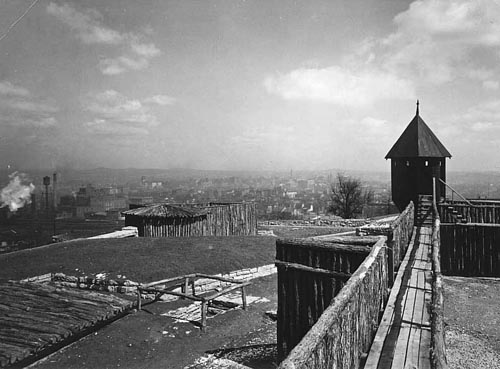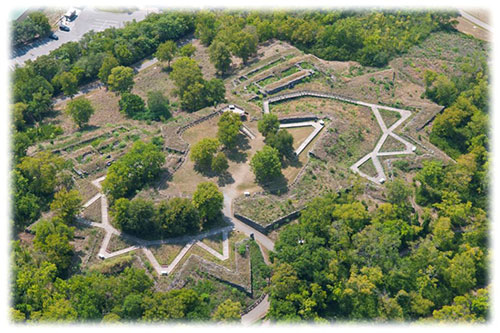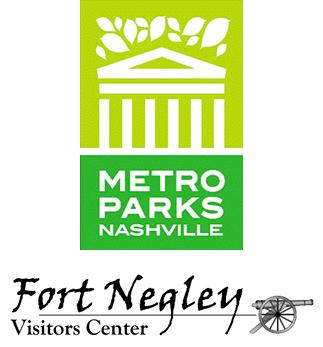As the largest inland stone fortification built during the Civil War, Fort Negley stood as the centerpiece of Union occupied Nashville. Fort Negley represents the effects of war, the decisive defeat of Western Theater Confederates at the Battle of Nashville, and the legacy of the Depression-era Works Progress Administration.
Nashville’s strategic location on the Cumberland River and networks of turnpikes and railroads made the city a valuable asset to both the Union and Confederate Armies. Following the surrender to the Union Army on February 25, 1862, Nashville became a fortified stronghold, second only to Washington D.C.

'Impressing Negroes to Work on the Nashville Fortifications,' Annuals of the Army of the Cumberland, John Fitch, 1864
From August through December 1862, more than 2700 conscript laborers, predominately contrabands (runaway slaves) and free Blacks, constructed Fort Negley, atop St. Cloud Hill, as part of a massive fortification system. Fort Negley’s location, size, and guns discouraged Confederate attacks throughout the war. During the Battle of Nashville, December 15 and 16, 1864, Fort Negley’s artillery aided in driving off General Hood’s forces.
Tennessee rejoined the Union in July 1867. Union forces occupied Nashville and Fort Negley until September. At that time, the army dismantled the majority of Nashville’s defenses.
Following failed efforts to preserve Fort Negley as a national military park, St. Cloud Hill once again became a popular picnic area. The City of Nashville purchased the property in 1928. In 1936, 800 men working for the Works Progress Administration reconstructed Fort Negley at a cost of $84,000. The Fort reopened to the public in 1938. In the 1960s, Metro Parks removed the deteriorated stockade and closed the Fort to the public.

WPA Reconstruction, Circa 1938
Interest in Fort Negley grew during the 1990s. The Parks and Greenways Master Plan made restoration and interpretation of the Fort a priority. The City of Nashville appropriated funds for the project in 2002. The project remains the largest expenditure of city funds in the nation for the preservation of a Civil War site. Fort Negley, reopened to the public on the 140th anniversary of the Battle of Nashville in December 2004, offers interpretive panels and accessible walkways.

Fort Negley, 2011
Fort Negley Visitors Center, opened in December 2007, features two films, access to the Civil War Soldier and Sailors System maintained by the National Park Service, and interactive touch screens highlighting occupied Nashville and Fort Negley.
Fort Negley Visitors Center partners with history and preservation groups, presents educational programming, and serves as the home of the Nashville Civil War Roundtable and Fort Donelson Camp 62, Sons of Union Veterans.
Master Plans and Other Guiding Documents
Visit the Fort Negley Planning and Development page
Frequently Asked Questions
There were many forts throughout Nashville during the war. Fort Negley was the most prominent but nearby were blockhouse Casino and Fort Morton. Fort Houston was closer to downtown at site of the present day Music City roundabout. Fort Gillem was located on what later became the campus of Fisk University. Fort Garesche was located in North Nashville between Fort Gillem and the Cumberland River.
Following Nashville’s surrender to the Union Army February 25, 1862, the city became a supply, transportation and hospital hub and a base for military operations in the western theater. The Union army began fortifying the city during the summer of 1862 to defend against possible Confederate attacks.
Brochures
Find These Brochures and More at Fort Negley Visitors Center
Fort Negley Visitors Center
A Dozen Facts About the Fort
The Art of Fortification
The Battle of Nashville
Occupied Nashville: The Great Panic
Children and the Civil War
United States Colored Troops
Civil War Amputation
Suggested Readings and Sources
Battle of Nashville Driving Tour
Occupied City Walking Tour

